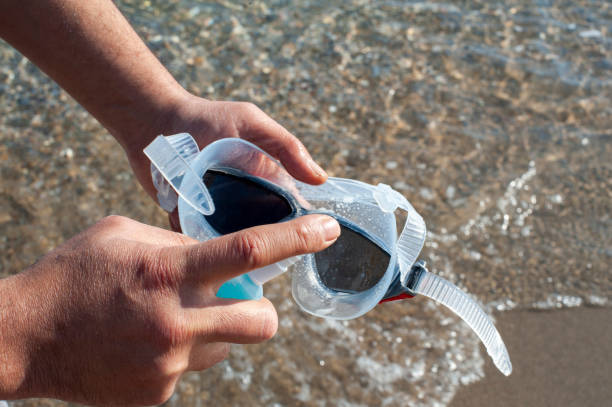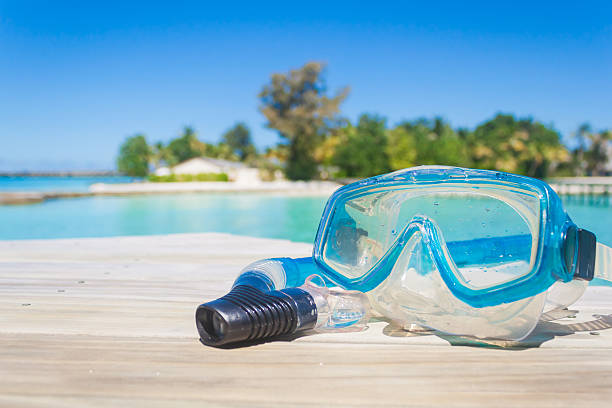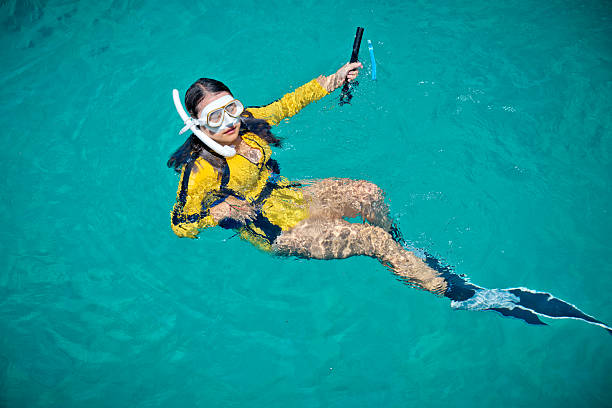Приключение с маской и трубкой сродни открытию сокровищницы подводных чудес. Однако среди очарования яркой морской жизни и кристально чистой воды кроется первостепенная необходимость в безопасности. В этом всеобъемлющем руководстве мы углубимся в то, как безопасно заниматься сноркелингом, подчеркивая чрезвычайную важность приоритета безопасности на каждом шагу. От преимуществ снорклинга с надлежащими мерами предосторожности до ключевых советов по безопасности, эта статья снабжает энтузиастов знаниями и осведомленностью, необходимыми для исследования глубин с уверенностью и спокойствием. Присоединяйтесь к нам, когда мы будем исследовать увлекательное царство безопасных методов снорклинга, гарантируя всем незабываемые подводные впечатления.
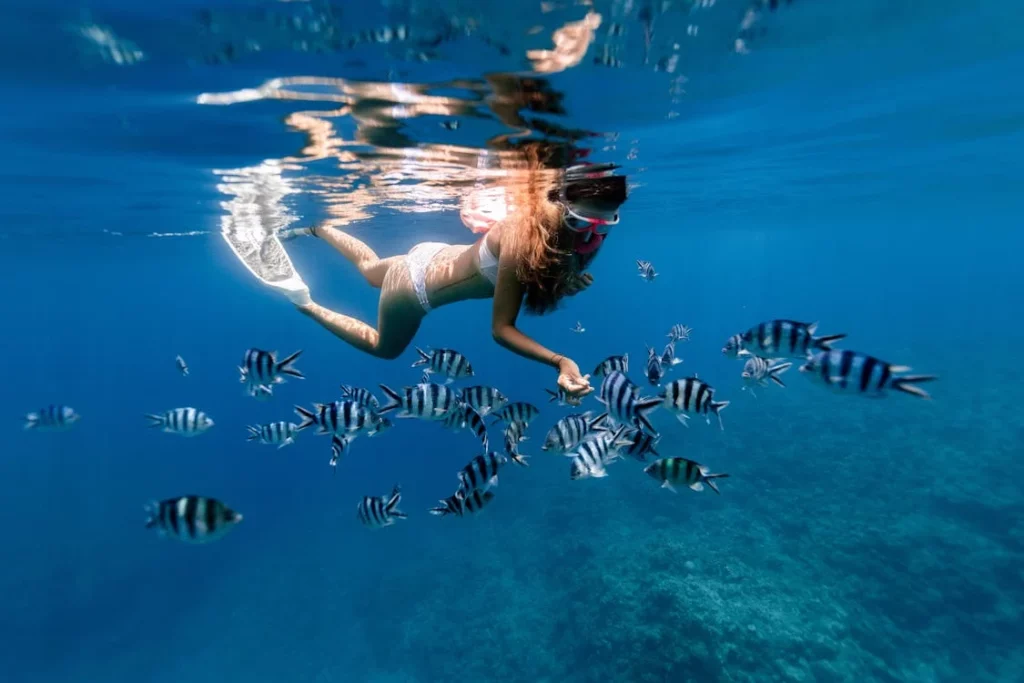
Подготовьте правильное снаряжение для подводного плавания
Прежде чем отправиться в подводное приключение, соберите правильное снаряжение для подводного плавания является основополагающим шагом к безопасности и удовольствию. Статистика показывает, что хорошо подобранная маска снижает риск протечек на 85%, а правильно обтекаемые ласты повышают эффективность плавания на 30%. Оснащение себя качественным снаряжением повышает комфорт, снижает усталость и оптимизирует ваши общие впечатления от сноркелинга.
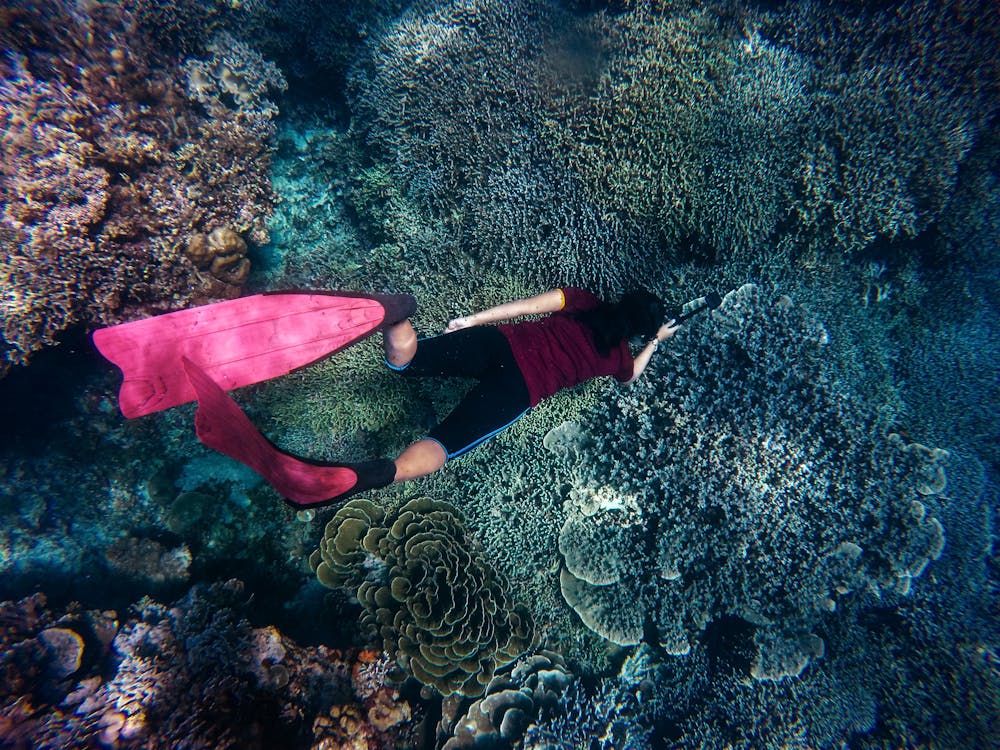
Удобная маска
Плотно прилегающая маска — это не только видимость; это ключевой компонент безопасности. Хорошо прилегающая маска предотвращает попадание воды, обеспечивая четкое зрение и беспрепятственное исследование подводного мира.
Советы по покупке: При выборе маски отдайте приоритет посадке. Убедитесь, что она плотно прилегает к лицу, не вызывая дискомфорта или давления. Выбирайте маску с мягкой силиконовой юбкой, которая облегает контуры вашего лица для обеспечения водонепроницаемости. Проверьте маску, слегка прижав ее к лицу без ремешка; если она остается на месте, скорее всего, она хорошо прилегает.
Правильно подобранная трубка
Трубка — это не просто дыхательный аппарат; это спасательный круг. Правильно подобранная трубка облегчает дыхание, снижает усталость и повышает комфорт во время сеанса подводного плавания.
Советы по покупке: Выберите трубку с удобным загубником, который надежно фиксируется между зубами и губами. Убедитесь, что длина трубки соответствует вашему росту, позволяя верхней части трубки оставаться над водой при плавании лицом вниз. Обратите внимание на такие особенности, как продувочные клапаны или брызговики, чтобы предотвратить попадание воды и обеспечить плавное дыхание.
Обтекаемые плавники
Ласты не только для движения; они необходимы для маневренности и безопасности. Обтекаемые ласты обеспечивают эффективное движение, сохраняя энергию и позволяя любителям подводного плавания с маской и трубкой легко ориентироваться в течениях.
Советы по покупке: При выборе ласт отдавайте приоритет комфорту, посадке и производительности. Выбирайте ласты с регулируемыми ремешками, чтобы подогнать их по размеру и предотвратить натирание или появление волдырей. Выбирайте ласты из легких, но прочных материалов, таких как высококачественная резина или силикон. Учитывайте конструкцию лопасти: более длинные и узкие лопасти обеспечивают более эффективное движение, а более короткие лопасти обеспечивают лучшую маневренность в ограниченном пространстве.
Узнайте о погоде и состоянии воды
Динамическое взаимодействие погодных и водных условий имеет первостепенное значение для безопасных и приятных экскурсий с маской и трубкой. Исследования показывают, что 70% несчастных случаев во время подводного плавания происходят из-за недостаточной осведомленности о погодных условиях и состоянии воды. Проверка прогнозов погоды и оценка видимости воды могут значительно снизить риск попадания в опасные ситуации, обеспечивая безопасный и приятный подводный опыт.
Проверьте прогнозы погоды
Прежде чем надевать снаряжение, ознакомьтесь с надежными прогнозами погоды. Внезапные штормы или сильные ветры могут превратить спокойные воды в бурные моря, создавая риски даже для самых опытных любителей подводного плавания.
Оцените видимость воды и приливы
Чтобы оценить видимость воды, ищите чистую, прозрачную воду, указывающую на хорошую видимость, в то время как мутная или мутная вода может означать плохую видимость из-за осадка или водорослей. Кроме того, проверьте карты приливов, чтобы понять направление и силу приливных течений, обеспечить безопасную навигацию и избежать опасных условий. Не забудьте планировать свои экскурсии по сноркелингу в периоды оптимальной видимости и когда приливные течения минимальны для более безопасного подводного опыта.
Распознавать опасную морскую жизнь
Распознавание опасной морской жизни имеет решающее значение для избежания потенциально опасных встреч во время подводного плавания. Вот некоторые примеры опасной морской жизни:
- Медуза: Контакт с некоторыми видами медуз может привести к болезненным укусам, вызывающим раздражение кожи, аллергические реакции или даже более серьезные проблемы со здоровьем.
- Морские ежи: Наступание на морских ежей или случайное соприкосновение с ними может привести к болезненным колотым ранам, которые часто приводят к воспалению и инфекции, если их не лечить своевременно.
- Скаты: У скатов на хвосте есть ядовитое жало, которое они могут использовать в целях самообороны, если им угрожает опасность или на них случайно наступят любители подводного плавания. Мурены: хотя мурены и не агрессивны, они могут укусить, если их спровоцировать или если любители подводного плавания подойдут слишком близко к их укрытиям, что приведет к глубоким ранам и потенциальной инфекции.
- Рыба-лев: Рыба-лев имеет ядовитые шипы, которые могут вызвать болезненные уколы, если к ним прикоснуться. Их яркий внешний вид может привлечь любителей подводного плавания, но следует проявлять осторожность, чтобы избежать случайных встреч.
- Акулы: Хотя нападения акул на любителей подводного плавания редки, некоторые виды акул могут представлять опасность в определенных местах. Понимание поведения акул и избегание мест, известных активностью акул, может помочь минимизировать риск встреч.
Осознание этих потенциальных опасностей и принятие превентивных мер, таких как избегание контакта, поддержание безопасной дистанции и уважение среды обитания морских обитателей, может значительно снизить риск получения травм во время подводного плавания.
Подумайте о физическом здоровье
Правильная физическая подготовка, водный баланс и осознание собственных возможностей являются важнейшими элементами обеспечения вашего благополучия во время исследования подводной среды.
Обеспечить физическую форму
Адекватная физическая подготовка необходима для того, чтобы выдерживать и наслаждаться приключениями сноркелинга. Исследования показали, что люди с более высоким уровнем сердечно-сосудистой подготовки испытывают меньшую усталость и лучшую выносливость во время водных видов деятельности, таких как сноркелинг.
Поэтому вам необходимо регулярно заниматься кардио- и силовыми тренировками, чтобы повысить выносливость и выносливость, обеспечивая длительное подводное исследование без усталости. Кроме того, отдавайте приоритет гидратации и сбалансированному питанию, чтобы подпитывать свое тело для оптимальной производительности и устойчивости к физическим нагрузкам. Более того, правильная гидратация и питание до, во время и после занятий сноркелингом имеют решающее значение для пополнения электролитов и предотвращения обезвоживания, которое может привести к мышечным спазмам и истощению под водой.
Знайте свои пределы и ограничения по здоровью
Будьте честны с собой относительно своих плавательных способностей, уровня выносливости и любых имеющихся заболеваний, которые могут повлиять на ваши подводные способности. Уважайте сигналы своего тела и не выходите за пределы зоны комфорта, чтобы избежать несчастных случаев или неотложных медицинских ситуаций во время подводного плавания.
Примечание*: Лица с респираторными заболеваниями, такими как астма или заболевания сердца, должны проконсультироваться с лечащим врачом, прежде чем заниматься подводным плаванием.
Освойте технику подводного плавания
Правильные методы повышают ваш комфорт и эффективность и значительно снижают риск несчастных случаев. Давайте углубимся в основы методов подводного плавания, начиная с эффективного дыхания.
Правильные методы дыхания
Правильные методы дыхания являются основополагающими для подводного плавания. Дыхание через трубку требует спокойного, контролируемого дыхания, чтобы избежать всасывания воды. Практикуйте медленный и глубокий вдох через рот, заполняя легкие, а затем полностью выдыхая. Это ритмичное дыхание обеспечивает постоянную подачу кислорода, снижая усталость и помогая вам оставаться расслабленным.
Методы эффективного дыхания
Эффективные техники дыхания включают в себя больше, чем просто основы. Для оптимальной производительности координируйте дыхание с движениями. Во время плавания делайте медленные, осознанные вдохи. Если вам нужно нырнуть под поверхность, сделайте глубокий вдох и задержите дыхание, плавно выдыхая при всплывании. Эта техника экономит энергию и помогает предотвратить попадание воды в трубку.
Советы по предотвращению гипервентиляции
Гипервентиляция может быстро привести к головокружению и панике, и то и другое опасно во время подводного плавания. Чтобы избежать этого, сосредоточьтесь на поддержании медленного и ровного дыхания. Избегайте быстрых, поверхностных вдохов, которые могут истощить уровень углекислого газа и нарушить ваш ритм дыхания. Если вы чувствуете одышку, остановитесь, поплавайте и найдите время, чтобы отрегулировать дыхание, прежде чем продолжить.
Понять эффективное плавание и движение
Эффективное плавание и движение имеют решающее значение для сохранения энергии и навигации в различных водных условиях во время подводного плавания. Освоение этих навыков позволяет вам исследовать больше и безопаснее. Давайте рассмотрим ключевые стратегии для улучшения вашей подводной мобильности.
Советы по экономии энергии
Используйте обтекаемые движения, чтобы уменьшить сопротивление, сохраняя горизонтальное положение тела и близко к поверхности. Эффективно используйте ласты, отталкиваясь от бедер с минимальным сгибанием колена, что максимизирует толчок и минимизирует усталость. Кроме того, практикуйте расслабленные, ритмичные гребки, чтобы поддерживать постоянный темп, не перенапрягаясь.
Маневрирование в различных водных условиях
Различные водные условия требуют адаптивных методов маневрирования. В спокойной воде поддерживайте устойчивый, плавный темп, используя ласты для скольжения без усилий. В неспокойных или турбулентных условиях используйте более сильные, более обдуманные удары ногами, чтобы противостоять течению. При навигации через рифы или скалистые участки практикуйте точные, контролируемые движения, чтобы избегать столкновений и сохранять деликатную морскую среду.
Чистая вода из вашей трубки
Затопленная трубка может быстро превратить приятное плавание с маской и трубкой в паническую борьбу. Умение очищать трубку от воды является жизненно важным навыком для обеспечения безопасности под водой.
Методы очистки затопленной трубки
Существует несколько эффективных методов очистки затопленной трубки. Метод выталкивания заключается в сильном выдохе в трубку для выталкивания воды через верх. В качестве альтернативы метод вытеснения требует откидывания головы назад и естественного вытекания воды при медленном вдохе. Оба метода жизненно важны для того, чтобы трубка оставалась чистой и функциональной, что позволит вам быстро возобновить нормальное дыхание.
Сохраняйте спокойствие при попадании воды
Сохраняйте спокойствие, когда вода попадает в вашу трубку, чтобы избежать паники и обеспечить эффективную очистку. Если вы чувствуете, что вода попадает в трубку, прекратите плавать, сохраняйте расслабленное положение на плаву и используйте выбранный вами метод очистки. Паника может привести к гипервентиляции и дезориентации, поэтому для безопасного подводного плавания важно успокоиться и контролировать дыхание.
Соблюдайте меры безопасности во время подводного плавания
Меры безопасности имеют решающее значение для обеспечения безопасного и приятного опыта сноркелинга. Одной из наиболее эффективных стратегий безопасности является использование системы напарников и обеспечение надлежащего надзора. Давайте разберемся, почему эти практики необходимы.
Система напарников и надзор
Сноркелинг с партнером, также известный как система напарников, значительно повышает безопасность. Напарник по сноркелингу может оказать немедленную помощь в случае поломки оборудования, усталости или неотложной медицинской помощи, снижая риск несчастных случаев. Кроме того, наблюдение со стороны более опытного сноркелера или профессионального гида может дополнительно обеспечить безопасность, предоставляя руководство, контролируя условия и оперативно реагируя на любые возникающие проблемы. Наличие напарника и надлежащего наблюдения создает страховочную сетку, которая позволяет вам исследовать с уверенностью и душевным спокойствием.
Распознавать и устранять чрезвычайные ситуации
Распознавание и эффективное управление чрезвычайными ситуациями имеет первостепенное значение для безопасного подводного плавания. Готовность к неожиданным ситуациям может стать решающим фактором между незначительным инцидентом и серьезной аварией. Давайте рассмотрим, как распознать признаки бедствия, предпринять соответствующие шаги в чрезвычайных ситуациях и подать сигнал о помощи.
Определите признаки бедствия
Обычные признаки включают в себя быстрое или нерегулярное дыхание, судорожные или нескоординированные движения, чрезмерную усталость и видимую панику. Если вы заметили любой из этих признаков, важно действовать быстро и оказать помощь. Будьте бдительны и регулярно проверяйте своего напарника по сноркелингу, чтобы убедиться в его благополучии.
Действия в случае чрезвычайной ситуации
В случае возникновения чрезвычайной ситуации сохраняйте спокойствие и следуйте следующим шагам:
- Остановка и плавание: Немедленно прекратите любую интенсивную деятельность и плывите на спине, чтобы экономить энергию и сохранять плавучесть.
- Сигнал о помощи: Используйте общепринятые сигналы руками или зовите на помощь своего напарника или находящихся поблизости любителей подводного плавания.
- Помогите своему приятелю: Если ваш товарищ в беде, подойдите к нему спокойно и окажите поддержку. Поддерживайте его на плаву и поощряйте медленное, глубокое дыхание, чтобы уменьшить панику.
- Выход из воды: При необходимости помогите пострадавшему ныряльщику безопасно выбраться из воды. Используйте плавсредства или обратитесь за помощью к другим, если это необходимо.
Как подать сигнал о помощи?
Эффективная коммуникация жизненно важна в чрезвычайных ситуациях. Используйте эти методы, чтобы подать сигнал о помощи:
- Сигналы руками: Вытяните одну руку вверх и помашите ею из стороны в сторону, чтобы выразить беспокойство.
- Свист: Носите с собой водонепроницаемый свисток и используйте его для привлечения внимания короткими, резкими звуками.
- Сигналы системы Buddy: Установите набор заранее согласованных сигналов с вашим напарником перед погружением с маской и трубкой. Они могут включать постукивание по голове, чтобы показать, что вы возвращаетесь на поверхность, или сжатие кулака, чтобы подать сигнал о необходимости помощи.
- Аварийное плавучее устройство: Если возможно, используйте аварийное плавучее средство, чтобы подать сигнал о помощи и обеспечить дополнительную плавучесть.
Защитите морскую среду
Ныряльщики с маской и трубкой могут защитить морские экосистемы, следуя нескольким основным правилам. Во-первых, не прикасайтесь к коралловым рифам и не стойте на них, так как они хрупкие и их легко повредить. Во-вторых, используйте солнцезащитный крем, безопасный для рифов, чтобы предотвратить попадание в воду вредных химических веществ. В-третьих, практикуйте ответственную утилизацию отходов, не оставляя мусора и подбирая все, что видите. Кроме того, держитесь на почтительном расстоянии от морских животных, чтобы не нарушать их естественное поведение. Наконец, поддерживайте местные усилия по охране природы и просвещайте других о важности сохранения морской среды. Придерживаясь этих правил, ныряльщики с маской и трубкой могут наслаждаться красотой океана, одновременно способствуя его сохранению.
Руководство по уважительному взаимодействию с морской жизнью
При подводном плавании держитесь на почтительном расстоянии от морских обитателей. Не преследуйте, не трогайте и не кормите рыб и других морских существ. Наблюдение на расстоянии снижает стресс у животных и минимизирует риск вредного взаимодействия. Помните, что мы гости в их домах, и наши действия должны отражать уважение и заботу об их благополучии.
Не трогать и не беспокоить коралловые рифы
Коралловые рифы — это хрупкие экосистемы, которые легко повреждаются при контакте с человеком. Воздержитесь от прикосновения или вставания на кораллы, так как это может нанести непоправимый вред. Даже легкое прикосновение может нарушить хрупкий баланс рифа, что приведет к обесцвечиванию или гибели коралловых полипов. Используйте надлежащий контроль плавучести, чтобы перемещаться вокруг рифов, не вступая в контакт, гарантируя, что эти яркие места обитания останутся нетронутыми для будущих поколений.
Используйте солнцезащитный крем Reef-Safe
Традиционные солнцезащитные кремы содержат химикаты, такие как оксибензон и октиноксат, которые вредны для коралловых рифов. Выбирайте безопасные для рифов солнцезащитные кремы, которые используют минеральные ингредиенты, такие как оксид цинка или диоксид титана. Эти альтернативы обеспечивают эффективную защиту от ультрафиолета, не внося вредных веществ в морскую среду. Выбирая безопасные для рифов продукты, вы вносите вклад в сохранение коралловых рифов и морской жизни.
Не забудьте позаботиться о себе после сноркелинга
После подводного плавания с маской и трубкой крайне важно тщательно промыть снаряжение пресной водой, чтобы удалить соль, песок и любые потенциальные загрязнители. Полностью высушите снаряжение, желательно в затененном месте, чтобы избежать попадания прямых солнечных лучей, которые могут испортить материалы. Осмотрите все предметы на предмет повреждений, таких как разрывы на ремешке маски, трещины на трубке или ласты с признаками износа. Храните снаряжение в прохладном сухом месте, чтобы предотвратить рост плесени и грибка. Регулярное техническое обслуживание, включая замену любых изношенных деталей, гарантирует, что ваше снаряжение будет в идеальном состоянии, обеспечивая вам безопасный и приятный опыт подводного плавания каждый раз.
Правильно чистите и храните оборудование
После каждого сеанса сноркелинга тщательно очищайте снаряжение, чтобы удалить соль, песок и мусор. Прополощите маску, трубку и ласты пресной водой, уделяя особое внимание щелям, где могут скапливаться частицы. При необходимости используйте мягкое мыло для удаления любых стойких остатков. Правильное хранение снаряжения в прохладном сухом месте предотвращает повреждение от длительного воздействия солнца и соли, сохраняя его функциональность.
Промойте и высушите свое снаряжение
Промывание снаряжения необходимо для предотвращения коррозии и деградации. После очистки дайте снаряжению полностью высохнуть на воздухе, прежде чем убрать его на хранение. Повесьте ласты, маску и трубку в хорошо проветриваемом помещении, чтобы обеспечить полную просушку. Этот шаг помогает предотвратить рост плесени и грибка, которые могут нарушить целостность снаряжения и привести к появлению неприятных запахов.
Проверка на износ
Регулярный осмотр вашего снаряжения для подводного плавания имеет жизненно важное значение для выявления и устранения любых признаков износа. Проверьте маску на наличие трещин или поврежденных уплотнителей, осмотрите трубку на предмет засоров или повреждений загубника, а также осмотрите ласты на предмет трещин или ослабленных ремней. Своевременное устранение незначительных проблем может предотвратить поломку снаряжения во время вашего следующего приключения с подводным плаванием, гарантируя безопасность и надежность.
Заключение
Сноркелинг, ворота в завораживающий подводный мир, предлагает непревзойденные впечатления для любителей приключений. Соблюдение мер безопасности не просто благоразумно; оно необходимо для максимального удовольствия и минимизации рисков. Научившись безопасно плавать с маской и трубкой и придерживаясь изложенных рекомендаций, любители снорклинга могут с уверенностью исследовать, гарантируя себе незабываемые подводные приключения на долгие годы.
Часто задаваемые вопросы
В чем секрет снорклинга?
Секрет полноценной экскурсии по сноркелингу заключается в поддержании расслабленного поведения и сохранении энергии. Плавайте неторопливо, дышите глубоко и размеренно, воздержитесь от лишних размышлений и наслаждайтесь каждым моментом приключения.
Как дышать под водой с трубкой?
Чтобы дышать под водой с трубкой, расположите загубник трубки между губами, обеспечив плотное прилегание. Расслабьте мышцы лица и дышите медленно и равномерно через рот. Выдыхайте осторожно, чтобы удалить воду из трубки, поддерживая постоянный ритм для облегчения комфортного и эффективного дыхания.
Каковы правила безопасности при плавании с маской и трубкой?
Безопасные методы подводного плавания включают в себя:
- Система приятелей: Всегда занимайтесь подводным плаванием с напарником, чтобы оказать помощь в чрезвычайных ситуациях.
- Проверить условия: Перед входом оцените погоду, видимость воды и приливы.
- Уважайте морскую жизнь: Не трогайте и не беспокойте морских обитателей.
- Очистить снаряжение: Узнайте, как очистить трубку и маску от воды.
- Сохраняйте спокойствие: Сохраняйте спокойствие и уравновешенность в воде, чтобы экономить энергию и избегать паники.
Как предотвратить нападения акул во время подводного плавания?
Хотя нападения акул случаются редко, существуют меры предосторожности, позволяющие снизить риск:
- Избегайте заката и рассвета: В это время акулы более активны.
- Оставайтесь в группах: Акулы реже приближаются к большим группам людей.
- Избегайте яркой одежды: Носите одежду нейтральных цветов, чтобы гармонировать с окружающей средой.
- Не плавайте вблизи мест рыбной ловли: Избегайте мест, где рыбаки активно ловят рыбу.
- Уважайте морскую жизнь: Не беспокойте и не провоцируйте акул и других морских обитателей.
Безопасно ли плавание с маской и трубкой для новичков?
Сноркелинг может быть безопасным для новичков при наличии надлежащих инструкций, оборудования и присмотра. Важно начинать в спокойной мелководной воде, практиковать базовые навыки и постепенно набираться уверенности. Новичкам также следует соблюдать правила безопасности, включая сноркелинг с напарником и поддержание своего уровня комфорта.
Могу ли я заниматься сноркелингом, если я не очень хорошо плаваю?
Да, вы можете плавать с маской и трубкой, даже если вы не очень хорошо плаваете. Придерживайтесь мелководья, спокойной воды, где вы можете стоять, если это необходимо. Используйте плавучие средства, такие как жилеты для плавания с маской или нудлы, для дополнительной плавучести. Практикуйте технику дыхания и держитесь ближе к берегу или плавучему средству для безопасности. Всегда плавайте с маской и трубкой с напарником, который может помочь при необходимости.
Кому не следует заниматься сноркелингом?
Лица, которые некомфортно чувствуют себя в воде, имеют респираторные заболевания, которые могут усугубляться при подводном плавании, или неспособны соблюдать правила безопасности, должны избегать подводного плавания. Кроме того, лица с определенными медицинскими состояниями, такими как неконтролируемая эпилепсия или сердечные заболевания, должны проконсультироваться с врачом перед тем, как заняться подводным плаванием.
